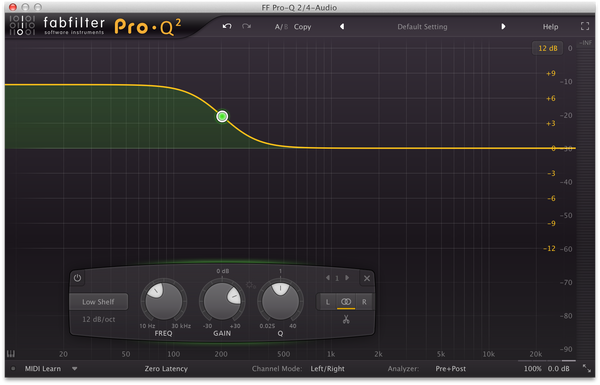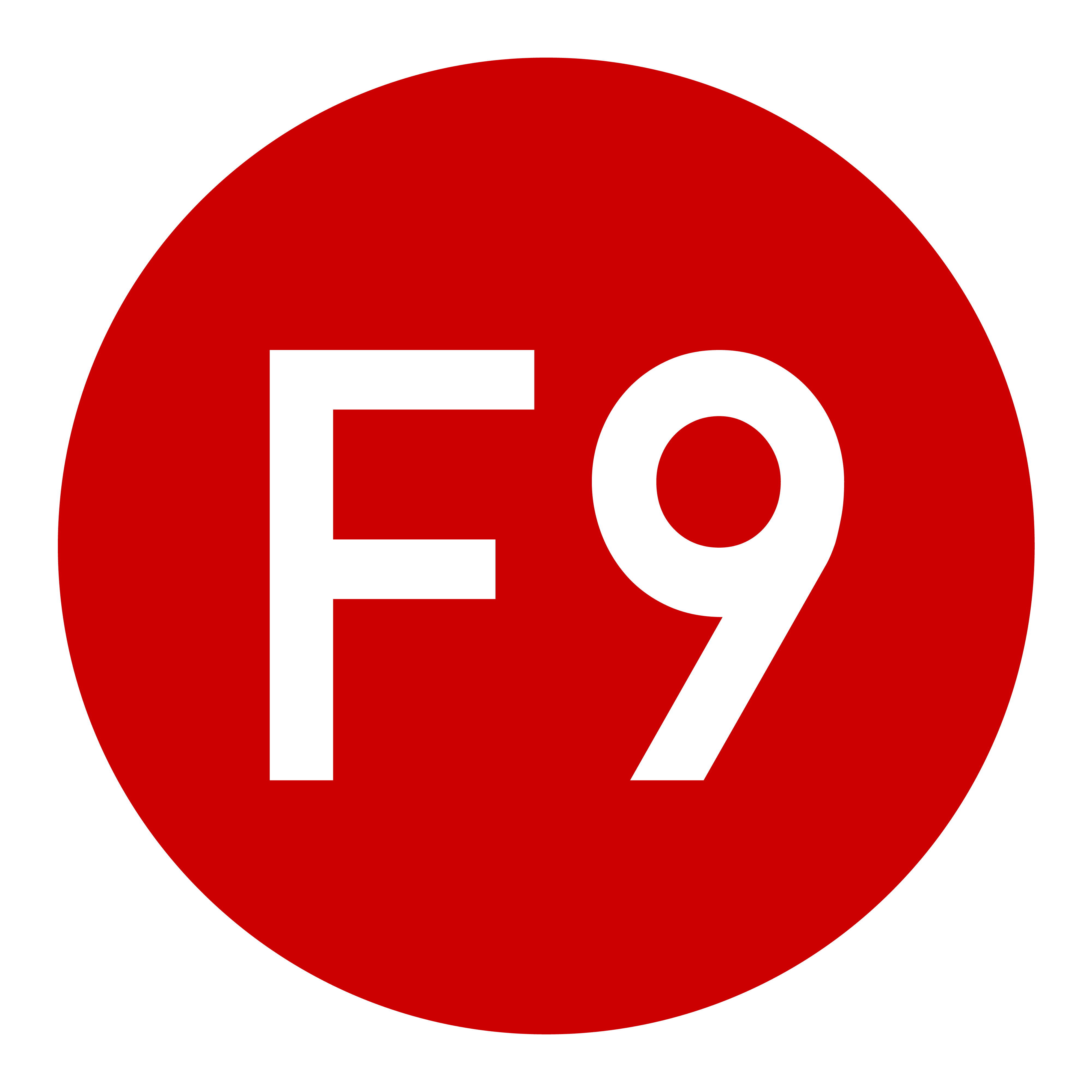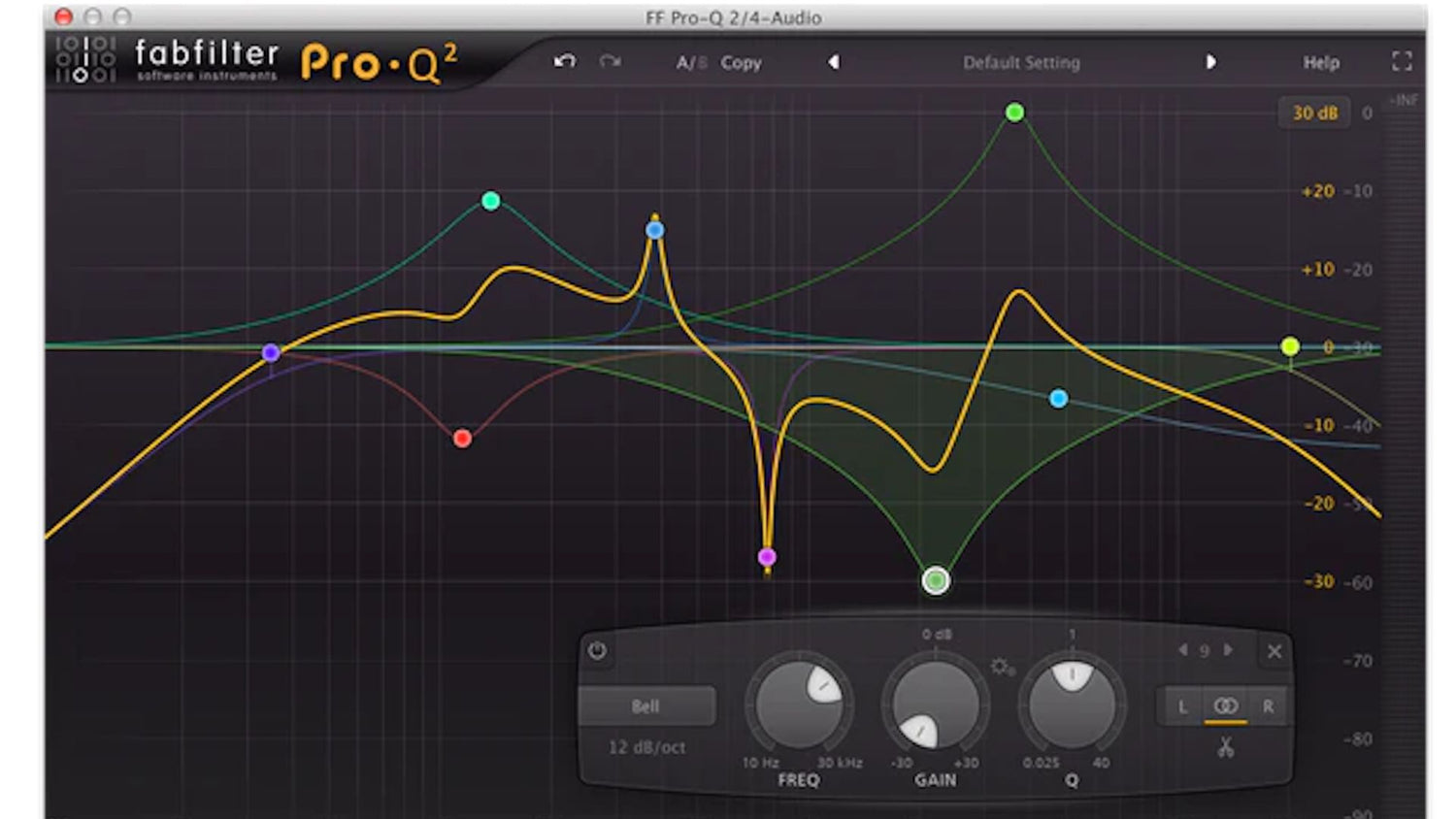The use of EQ is one of the best Skills any producer or engineer can master but like anything it takes experience to truly get to grips with. It's often said we learn by our failures so below are 5 mistakes I've made and learnt from over the last 15 years in Studios.
1 - The Comb-Under
This is a trap that's easy to fall into and I've certainly been guilty of it a few times - You take out a resonance you are hearing in a particular sound with a sharp Q surgical strike. Then you hear another so you do the same thing again - Then another pops up a bit like that fairground game where you have to hit the moles with a mallet - eat sleep, mix, repeat and before you know it you've got something like this:

This is basically a comb filter - The building block of the process used in phasers and by doing anything like the example above you are creating a similar effect to having a phaser across your audio but in a static position - Not good. Only the very finest digital EQ'S are capable of such Hi-Q notches and even then there are phase artefacts that are doing more damage than good to your audio. You may think Phase linear EQ'S can do a better job at this kind of manoeuvre but at Hi Q settings you often get pre-ringing as basically you are setting up more resonant processes.
Solution: Just don't do it. It really is as simple as that - turn the volume down a touch, walk away then come back to the project, take the EQ off and balance the audio properly in your production - Now think; How much EQ do I really need? Is there anything I can do to the source sound to make it better? (this will be a common thread throughout this post). Is there anything else clashing with this sound that I can tame gently?
After all that if you do need EQ, Use a wider Q value and only take out the frequency biggest offender, the rest will probably be OK. If it's still causing problems a multi band limiter or compressor can usually be much more helpful working ONLY in the problematic range - I highly recommend Fab Filter's Pro-MB for this.
Lesson: Hi Q Values should be used very sparingly - Most digital EQ's just don't do them as well as the visuals suggest!
2 - The Flabby Bottom
Shelf EQ filters are very easy to use, normally with fewer controls than their parametric cousins and with nearly every EQ having one as standard they are a daily part of the producer and engineers toolbox , But in my experience they are often used in error without their natural companion - the Hi pass filter or bass roll off. Consider this Standard Shelf filter response:

The frequency point or corner frequency as it's sometimes known is set to around 200HZ giving a lift to everything beneath that and it's a move everyone will make at some point (and probably every day in production). Now look at the left hand side of the graph - we are boosting all the troublesome sub regions here buy a large mile so if there's sub sonics in the signal these are going to get boosted enormously.
In the days of Analogue tape, wires and transformers this may not have been as much of a problem as everything in analogue world of connectivity has a natural roll off at the lowest and highest ends of the Audio spectrum but modern DAW systems are capable of creating What I often call Theoretical frequencies - Sub sonics Waaaaaayyyyy below what is actually needed or wanted. The most useful part of bass lives between about 45 HZ and 100Hz and anything beneath 45hz should only be there if it's really needed and then only in small quantities and on carefully chosen sounds. Sub eats your mixes head room and is often the biggest cause of a flabby or distorting mix.
Solution: Using a Hi-pass filter in tandem with a Low end Shelf EQ move - every single time. It'll allow you to control the amount of Subsonic information in the signal after the shelf has done it's job and will be a revelation once you get to know it's response. Only practice will make you truly get to grips with this relationship but it's often where the magic is in bass mixing.

So yes I am suggesting that to get better bass you often have to take some off. I always remember first using U-he's amazing DIVA synth and couldn't understand why I couldn't get some bass parts to fit - Like the synths models, Moogs etc it generates some incredible Subsonics that are often not even replicated on the speakers I was using and without the natural filtering qualities of cables and pre-amps that hardware can benefit from they were running riot. Taming them with Hi pass filters and careful EQ were the only way to make it sing on the bottom end.
Tip - Go and check the frequency responses of your main monitors, now check the response of a decent pair of headphones - My Event Opals start to roll off at 44HZ where as the amazing B+W P7 Headphones I've been using for help in mixing go at least one octave below that to about 22HZ. Now this is one vital thing to understand about the bass end of music - 44 Hz is 1 whole musical octave above 22 HZ so unless you have something that can replicate those sounds you will not ever truly know what's going on down there which is why for modern club productions I always recommend using a Pair of headphones as well as studio monitors - more on this later.
Lesson - A bass end Shelf filter should always be paired with a Bass cut or roll off (99.9% of the time).
3 - Brittle Tops
So this is very much related to the previous entry as we're still on shelf filters but this time at the top. How many times have you scanned through your EQ settings to see lots of this:

Well exactly the same problems of the previous example can occur but with the added problem of individual hearing and fatigue. Everyone's hearing is different and whilst treble and brightness are addictive (and increasingly important in todays highly pushed Mixing environment) shoving Top shelves on lots of channels (and with high gain settings) is often a very bad idea as you get a build up of fuzzy information that often you literally just cannot hear but is causing problems in your mix. Now that's not to say that your speakers can't replicate it but your ears just may not pick it up depending on your make up, age and how long you've been chained to the DAW for one session.
Although this will not eat your mixes headroom like subsonics it will make your work sound brittle, digital and just a little false and you may not realise till it's too late.
Solution: On individual elements try using a bell filter in the higher registers (with a wide Q) or use a Low pass filter in tandem with Hi shelf in a reverse example of the previous point With a bell filter you will be able to shuffle about on the required frequencies adding an ever increasing mountain of top end mess every time you insert a shelf. By fine tuning the frequency points to the actual part you will create a much better top end landscape to your mix - Also not everything in a mix can have tons of top on it in a clear mix - So pick specific elements that work and need to work within the top end of the spectrum an concentrate your EQ skills on those, once you've done them you may find that that loop you were just about to bung a shelf on it just doesnt need it!

Also check your source; Can opening a filter up on a synth create the top end lift you are after? changing the source is always a better move then rectifying with EQ
Tip - I find the best time for me to judge top end and balances of top end heavy instruments is first thing the next morning with a coffee and the little bit of extra time the mornings always seem to bring. My ears are rested so respond much better and I make all decisions in seconds rather than minutes (or sometimes hours).
Lesson - Try a bell EQ curve instead of a top shelf to avoid fizzy clutter in the top end and tailor it to the sounds. If you must use a shelf and you're using lots of boost just make sure you don't end up doing it a lot in your mix - Sometimes a simple top lift on the master buss can really stop you having to make loads of repeated moves. If you want to hear one of the best top end curves out there try the Air band on The Eiosis Air EQ.
4 - A Question of Q
So lets quickly think about the difference in the bottom and top portions of an EQ curve. As we said earlier the difference between 1 octave on the sub end can be only a few Hz and even at 100Hz the same note an octave up is only 200Hz, so all 12 notes of a scale fit in just those 100HZ of difference. If we look at the other end, a 3000Hz (3KHz) note has it's octave at 6000hz (6Khz) so all 12 notes would fit in 3000Hz - 30 times the space at the bottom.
So now ask yourself how often do you do this?

In this example there are two Hi-Q boosts on the top mids and a Low Q wide boost on the bottom but think about this in relation to what we've just discussed. We are creating two exceptionally resonant peaks that only affect a small amount of the signal and a large lump on the bottom that is affecting tons of potential bandwidth.
I'm now going to suggest something that has just worked for me as a general working practice over the years; Reverse this kind of EQ move. In general I find using wider EQ moves towards the top end and Tighter peaks at the bottom works much better. This isn't a rule, just something I think everyone should try and see if it you get better results:

The theory in my head goes like this: bass is easy to over work and clog up a mix so by being much more selective of the frequency range I'm boosting I can control it better. Top end resonance rarely sounds great on the mids and tops and by using wider and therefore smoother curves at the top (with some careful post EQ level balancing) just seem to make everything sound better.
No solutions or tips here, just start trying out this methodology and see if your work starts to sound more natural.
5 - The Frankly Ridiculous
Have a look at this:

Yeee Hawwww - Now that's what I call an Eq curve, and they wouldn't give us all this control without the need to use it right? And it's how all the pictures on the promotional blurb look like so It must be right? yes? Ah, No.
Now I'm all for some serious EQ on occasion bit if this is how your curve looks then something, somewhere is very wrong. These kind of curves may look great online and in promo emails and show off the graphical interfaces of modern EQ's but 9 times out of 10 if you're having to do this then you are using the wrong source sound or your audio has serious problems.
Solution: Try a different sound that simple. If you're having to bash the thing into submission then normally something else can do exactly the same job without causing all the phase and filtering problems that this kind of move will make but it's human nature to just assume that because you used that sound that it must just fit eventually. We tend to take the quickest path and changing an entire sound is a long job normally where as bashing it to bits with plugins often seems simpler or some reason (yes i've been there and own the t shirt factory). It is normally the definition of diminishing returns - Work on your sounds, work on your sounds again and then some more before you reach for anything like this.
I've been guilty of this one many times and only when we started working with the guys at Wired Masters and I saw the stem sessions come back with wonderfully simple EQ moves on did i finally realise. Balance and gentle EQ is the best way forward even in these time of high-pressure mixes. A 2Db change in Levels across a few elements can dramatically change a mix and solve way more problems than this can.
6 - The Pointless Boost
For many years when I first started; I used to do a whole lot of this hoping it would help thicken the sound:

As you can see from the underlying frequency graph, none of the actual audio is operating in the area boosted so I am doing absolutely no good at all, just creating a problem-waiting-to-happen should there suddenly be a pop or low thump on that channel. You simply cannot boost what's not there and even though this is number 6 it should probably be much higher up the list as it's a bad move plain and simple and can cause you problems that take a long time to work out.
Solution: Just don't do it and be more selective and careful of your boost points using analysers if needed.
An important word whilst using modern EQs (which may contradict some of the above). In these days of hi-rez frequency analysers and graphical displays it's all too easy to use the wrong sense whilst working with audio - always remember we listen with our ears not our eyes and sometimes I've caught my self thinking 'That must be wrong? look at it, it's crazy' after applying a touch of dramatic EQ .. Oldest rule in the book.
If it sounds right it is right: that's always worth keeping in mind.
These are suggestions not rules and are designed to be helpful parameters work within on a daily basis. Just also keep in mind that being an art form, music and audio will often benefit from colouring outside the lines from time to time. Knowing when to break the bounds is just as important as staying within them!
Hope you all find this helpful
James




17 comments
Leave a comment
This site is protected by hCaptcha and the hCaptcha Privacy Policy and Terms of Service apply.